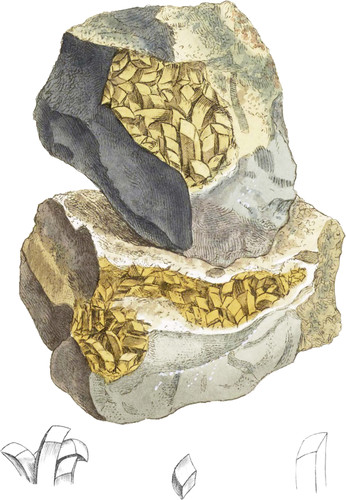 Enlarge
Enlarge
British Mineralogy
Carbonate of Lime
- Div. 1. Crystallized.
- Var. Inverse rhomb.
- Bournon Traité de Mineralogie, p. 34 t. 10. f. 152.
I know of no one who notices this form or crystallization excepting the Count de Bournon, who, in his work of great labour, observes that Sir John St. Aubyn’s valuable collection possesses it. Its peculiarity made me think it of too much consequence to be passed over here. It should appear no less so, when we find that the crystals are formed in the division of a septarium. They are a little founding in the general outline, so that the angles cannot be positively measured; but such as are conversant in crystallized Carbonate of Lime immediately recognise the inverse modification, more or less elongated by a continual aggregation upon one of the faces, so as to form a four-sided column*; and it seems that this crystallization took place while it was yet in a sofiish state, as they become as it were curved from weakness.
The terminal faces of the crystals are often rounded; sometimes the longer diagonal being the most elevated, and sometimes the shorter. They have a waxy and peculiarly shining hist re, and are from nearly white to a yellowish and greenish colour. The Tali of which they become Septæ are irregular, and composed of dark gray Marie coated with Brown Carbonate of Lime, and occasionally holding shells. The upper specimen shows part of three spires,—of which I shall speak in my Extraneous Fossils.
The specimens were presented to me by Miss Codrington: they were collected by her upon the Beach at Weymouth.
- * The perfect rhomb of this modification is not very rare: I have it from the same place. The crystals are, however, fixed in general upon one of the points.

